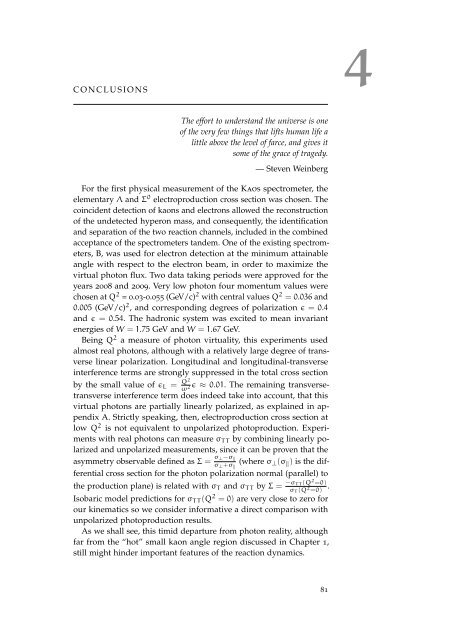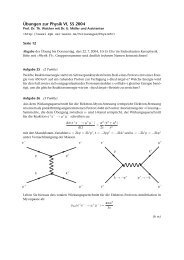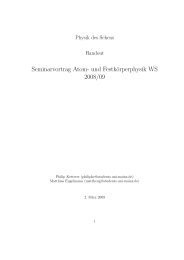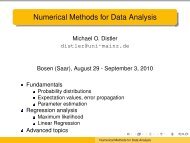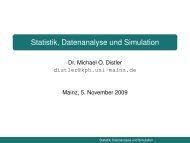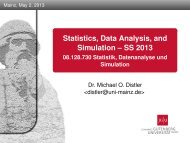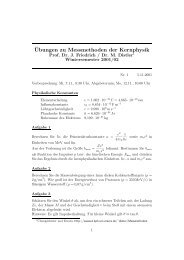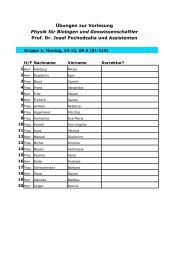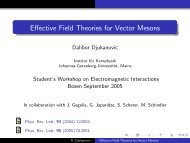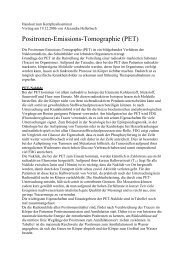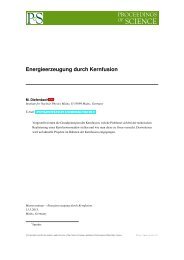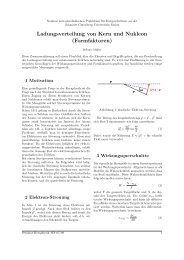A Classic Thesis Style - Johannes Gutenberg-Universität Mainz
A Classic Thesis Style - Johannes Gutenberg-Universität Mainz
A Classic Thesis Style - Johannes Gutenberg-Universität Mainz
Create successful ePaper yourself
Turn your PDF publications into a flip-book with our unique Google optimized e-Paper software.
C O N C L U S I O N S<br />
The effort to understand the universe is one<br />
of the very few things that lifts human life a<br />
little above the level of farce, and gives it<br />
some of the grace of tragedy.<br />
— Steven Weinberg<br />
For the first physical measurement of the Kaos spectrometer, the<br />
elementary Λ and Σ 0 electroproduction cross section was chosen. The<br />
coincident detection of kaons and electrons allowed the reconstruction<br />
of the undetected hyperon mass, and consequently, the identification<br />
and separation of the two reaction channels, included in the combined<br />
acceptance of the spectrometers tandem. One of the existing spectrometers,<br />
B, was used for electron detection at the minimum attainable<br />
angle with respect to the electron beam, in order to maximize the<br />
virtual photon flux. Two data taking periods were approved for the<br />
years 2008 and 2009. Very low photon four momentum values were<br />
chosen at Q 2 = 0.03-0.055 (GeV/c) 2 with central values Q 2 = 0.036 and<br />
0.005 (GeV/c) 2 , and corresponding degrees of polarization ɛ = 0.4<br />
and ɛ = 0.54. The hadronic system was excited to mean invariant<br />
energies of W = 1.75 GeV and W = 1.67 GeV.<br />
Being Q 2 a measure of photon virtuality, this experiments used<br />
almost real photons, although with a relatively large degree of transverse<br />
linear polarization. Longitudinal and longitudinal-transverse<br />
interference terms are strongly suppressed in the total cross section<br />
by the small value of ɛL = Q2<br />
ω 2 ɛ ≈ 0.01. The remaining transversetransverse<br />
interference term does indeed take into account, that this<br />
virtual photons are partially linearly polarized, as explained in appendix<br />
A. Strictly speaking, then, electroproduction cross section at<br />
low Q 2 is not equivalent to unpolarized photoproduction. Experiments<br />
with real photons can measure σT T by combining linearly polarized<br />
and unpolarized measurements, since it can be proven that the<br />
asymmetry observable defined as Σ = σ⊥−σ �<br />
σ⊥+σ � (where σ⊥(σ �) is the differential<br />
cross section for the photon polarization normal (parallel) to<br />
the production plane) is related with σT and σT T by Σ = −σT T (Q 2 =0)<br />
σT (Q 2 =0) .<br />
Isobaric model predictions for σT T (Q 2 = 0) are very close to zero for<br />
our kinematics so we consider informative a direct comparison with<br />
unpolarized photoproduction results.<br />
As we shall see, this timid departure from photon reality, although<br />
far from the “hot” small kaon angle region discussed in Chapter 1,<br />
still might hinder important features of the reaction dynamics.<br />
81<br />
4


